Virtual Hairstyle Service Using GANs & Segmentation Mask (Hairstyle Transfer System)
Abstract
1. Introduction
- A new space for blending images that is more capable of encoding feature spatial positions and maintaining feature details.
- A new algorithm for aligned embedding reference images that uses a semantic segmentation mask and alignment with existing GAN-embedding methods. The proposed algorithm can align and embed images with a high-quality result.
- A new method for image blending that can blend multiple images with a considerable enhancement in virtual hairstyle transfer.
2. Related Research
3. Proposed System
4. Experimental Results
4.1. High Resolution Datasets
4.2. Evaluation of Hairstyle System
5. Conclusions and Future Research
Author Contributions
Funding
Conflicts of Interest
References
- Goodfellow, I.; Pouget-Abadie, J.; Mirza, M.; Xu, B.; Warde-Farley, D.; Ozair, S.; Courville, A.; Bengio, Y. Generative adversarial networks. Commun. ACM 2020, 63, 139–144. [Google Scholar] [CrossRef]
- Radford, A.; Metz, L.; Chintala, S. Unsupervised representation learning with deep convolutional generative adversarial networks. arXiv 2015, arXiv:1511.06434. [Google Scholar]
- Metz, L.; Poole, B.; Pfau, D.; Sohl-Dickstein, J. Unrolled generative adversarial networks. arXiv 2016, arXiv:1611.02163. [Google Scholar]
- Mao, X.; Li, Q.; Xie, H.; Lau, R.Y.; Wang, Z.; Paul Smolley, S. Least squares generative adversarial networks. In Proceedings of the IEEE International Conference on Computer Vision, Venice, Italy, 22–29 October 2017; pp. 2794–2802. [Google Scholar]
- Abdal, R.; Qin, Y.; Wonka, P. Image2stylegan++: How to edit the embedded images? In Proceedings of the IEEE/CVF Conference on Computer Vision and Pattern Recognition, Seattle, WA, USA, 14–19 June 2020; pp. 8296–8305. [Google Scholar]
- Huang, X.; Belongie, S. Arbitrary style transfer in real-time with adaptive instance normalization. In Proceedings of the IEEE International Conference on Computer Vision, Venice, Italy, 22–29 October 2017; pp. 1501–1510. [Google Scholar]
- Saha, R.; Duke, B.; Shkurti, F.; Taylor, G.W.; Aarabi, P. Loho: Latent optimization of hairstyles via orthogonalization. In Proceedings of the IEEE/CVF Conference on Computer Vision and Pattern Recognition, Virtual, 19–25 June 2021; pp. 1984–1993. [Google Scholar]
- Tan, Z.; Chai, M.; Chen, D.; Liao, J.; Chu, Q.; Yuan, L.; Tulyakov, S.; Yu, N. MichiGAN: Multi-Input-Conditioned Hair Image Generation for Portrait Editing. ACM Trans. Graph. 2020, 39, 95. [Google Scholar] [CrossRef]
- Karras, T.; Laine, S.; Aila, T. A style-based generator architecture for generative adversarial networks. In Proceedings of the IEEE/CVF Conference on Computer Vision and Pattern Recognition, Long Beach, CA, USA, 15–20 June 2019; pp. 4401–4410. [Google Scholar]
- Karras, T.; Laine, S.; Aittala, M.; Hellsten, J.; Lehtinen, J.; Aila, T. Analyzing and improving the image quality of stylegan. In Proceedings of the IEEE/CVF Conference on Computer Vision and Pattern Recognition, Seattle, WA, USA, 14–19 June 2020; pp. 8110–8119. [Google Scholar]
- Karras, T.; Aittala, M.; Hellsten, J.; Laine, S.; Lehtinen, J.; Aila, T. Training generative adversarial networks with limited data. Adv. Neural Inf. Process. Syst. 2020, 33, 12104–12114. [Google Scholar]
- Karras, T.; Aila, T.; Laine, S.; Lehtinen, J. Progressive Growing of GANs for Improved Quality, Stability, and Variation. In Proceedings of the International Conference on Learning Representations, Vancouver, BC, Canada, 30 April–3 May 2018. [Google Scholar]
- Abdal, R.; Qin, Y.; Wonka, P. Image2stylegan: How to embed images into the stylegan latent space? In Proceedings of the IEEE/CVF International Conference on Computer Vision, Seoul, Korea, 27 October–2 November 2019; pp. 4432–4441. [Google Scholar]
- Shen, Y.; Yang, C.; Tang, X.; Zhou, B. Interfacegan: Interpreting the disentangled face representation learned by gans. IEEE Trans. Pattern Anal. Mach. Intell. 2020, 44, 2004–2018. [Google Scholar] [CrossRef] [PubMed]
- Bau, D.; Strobelt, H.; Peebles, W.; Wulff, J.; Zhou, B.; Zhu, J.Y.; Torralba, A. Semantic photo manipulation with a generative image prior. arXiv 2020, arXiv:2005.07727. [Google Scholar] [CrossRef]
- Choi, Y.; Uh, Y.; Yoo, J.; Ha, J.W. Stargan v2: Diverse image synthesis for multiple domains. In Proceedings of the IEEE/CVF Conference on Computer Vision and Pattern Recognition, Seattle, WA, USA, 14–19 June 2020; pp. 8188–8197. [Google Scholar]
- Yu, F.; Seff, A.; Zhang, Y.; Song, S.; Funkhouser, T.; Xiao, J. Lsun: Construction of a large-scale image dataset using deep learning with humans in the loop. arXiv 2015, arXiv:1506.03365. [Google Scholar]
- Brock, A.; Donahue, J.; Simonyan, K. Large scale GAN training for high fidelity natural image synthesis. arXiv 2018, arXiv:1809.11096. [Google Scholar]
- Deng, J.; Dong, W.; Socher, R.; Li, L.J.; Li, K.; Li, F.F. Imagenet: A large-scale hierarchical image database. In Proceedings of the 2009 IEEE Conference on Computer Vision and Pattern Recognition, Miami, FL, USA, 20–25 June 2009; pp. 248–255. [Google Scholar]
- Härkönen, E.; Hertzmann, A.; Lehtinen, J.; Paris, S. Ganspace: Discovering interpretable gan controls. Adv. Neural Inf. Process. Syst. 2020, 33, 9841–9850. [Google Scholar]
- Tewari, A.; Elgharib, M.; Bharaj, G.; Bernard, F.; Seidel, H.P.; Pérez, P.; Zollhofer, M.; Theobalt, C. Stylerig: Rigging stylegan for 3d control over portrait images. In Proceedings of the IEEE/CVF Conference on Computer Vision and Pattern Recognition, Seattle, WA, USA, 14–19 June 2020; pp. 6142–6151. [Google Scholar]
- Abdal, R.; Zhu, P.; Mitra, N.J.; Wonka, P. Styleflow: Attribute-conditioned exploration of stylegan-generated images using conditional continuous normalizing flows. ACM Trans. Graph. 2021, 40, 1–21. [Google Scholar] [CrossRef]
- Patashnik, O.; Wu, Z.; Shechtman, E.; Cohen-Or, D.; Lischinski, D. Styleclip: Text-driven manipulation of stylegan imagery. In Proceedings of the IEEE/CVF International Conference on Computer Vision, Montreal, QC, Canada, 10–17 October 2021; pp. 2085–2094. [Google Scholar]
- Frühstück, A.; Alhashim, I.; Wonka, P. Tilegan: Synthesis of large-scale non-homogeneous textures. ACM Trans. Graph. 2019, 38, 1–11. [Google Scholar] [CrossRef]
- Collins, E.; Bala, R.; Price, B.; Susstrunk, S. Editing in style: Uncovering the local semantics of gans. In Proceedings of the IEEE/CVF Conference on Computer Vision and Pattern Recognition, Seattle, WA, USA, 14–19 June 2020; pp. 5771–5780. [Google Scholar]
- Wu, Z.; Lischinski, D.; Shechtman, E. Stylespace analysis: Disentangled controls for stylegan image generation. In Proceedings of the IEEE/CVF Conference on Computer Vision and Pattern Recognition, Virtual, 19–25 June 2021; pp. 12863–12872. [Google Scholar]
- Kim, H.; Choi, Y.; Kim, J.; Yoo, S.; Uh, Y. Exploiting spatial dimensions of latent in gan for real-time image editing. In Proceedings of the IEEE/CVF Conference on Computer Vision and Pattern Recognition, Virtual, 19–25 June 2021; pp. 852–861. [Google Scholar]
- Chai, M.; Luo, L.; Sunkavalli, K.; Carr, N.; Hadap, S.; Zhou, K. High-quality hair modeling from a single portrait photo. ACM Trans. Graph. 2015, 34, 1–10. [Google Scholar] [CrossRef]
- Chai, M.; Wang, L.; Weng, Y.; Jin, X.; Zhou, K. Dynamic hair manipulation in images and videos. ACM Trans. Graph. 2013, 32, 1–8. [Google Scholar] [CrossRef]
- Weng, Y.; Wang, L.; Li, X.; Chai, M.; Zhou, K. Hair interpolation for portrait morphing. In Computer Graphics Forum; Wiley Online Library: Hoboken, NJ, USA, 2013; Volume 32, pp. 79–84. [Google Scholar]
- Wei, L.; Hu, L.; Kim, V.; Yumer, E.; Li, H. Real-time hair rendering using sequential adversarial networks. In Proceedings of the European Conference on Computer Vision (ECCV), Munich, Germany, 8–14 September 2018; pp. 99–116. [Google Scholar]
- Lee, C.H.; Liu, Z.; Wu, L.; Luo, P. Maskgan: Towards diverse and interactive facial image manipulation. In Proceedings of the IEEE/CVF Conference on Computer Vision and Pattern Recognition, Seattle, WA, USA, 14–19 June 2020; pp. 5549–5558. [Google Scholar]
- Jo, Y.; Park, J. Sc-fegan: Face editing generative adversarial network with user’s sketch and color. In Proceedings of the IEEE/CVF International Conference on Computer Vision, Seoul, Korea, 27 October–2 November 2019; pp. 1745–1753. [Google Scholar]
- Tewari, A.; Elgharib, M.; Bernard, F.; Seidel, H.P.; Pérez, P.; Zollhöfer, M.; Theobalt, C. Pie: Portrait image embedding for semantic control. ACM Trans. Graph. 2020, 39, 1–14. [Google Scholar] [CrossRef]
- Zhu, J.; Shen, Y.; Zhao, D.; Zhou, B. In-domain gan inversion for real image editing. In Proceedings of the European Conference on Computer Vision, Glasgow, UK, 23–28 August 2020; Springer: Cham, Switzerland, 2020; pp. 592–608. [Google Scholar]
- Zhu, P.; Abdal, R.; Qin, Y.; Femiani, J.; Wonka, P. Improved stylegan embedding: Where are the good latents? arXiv 2020, arXiv:2012.09036. [Google Scholar]
- Richardson, E.; Alaluf, Y.; Patashnik, O.; Nitzan, Y.; Azar, Y.; Shapiro, S.; Cohen-Or, D. Encoding in style: A stylegan encoder for image-to-image translation. In Proceedings of the IEEE/CVF Conference on Computer Vision and Pattern Recognition, Virtual, 19–25 June 2021; pp. 2287–2296. [Google Scholar]
- Fedus, W.; Goodfellow, I.; Dai, A.M. MaskGAN: Better Text Generation via Filling in the _. In Proceedings of the International Conference on Learning Representations, Vancouver, BC, Canada, 30 April–3 May 2018. [Google Scholar]
- Park, T.; Liu, M.Y.; Wang, T.C.; Zhu, J.Y. Semantic image synthesis with spatially-adaptive normalization. In Proceedings of the IEEE/CVF Conference on Computer Vision and Pattern Recognition, Long Beach, CA, USA, 15–20 June 2019; pp. 2337–2346. [Google Scholar]
- Choi, Y.; Choi, M.; Kim, M.; Ha, J.W.; Kim, S.; Choo, J. Stargan: Unified generative adversarial networks for multi-domain image-to-image translation. In Proceedings of the IEEE Conference on Computer Vision and Pattern Recognition, Salt Lake City, UT, USA, 18–22 June 2018; pp. 8789–8797. [Google Scholar]
- He, K.; Gkioxari, G.; Dollár, P.; Girshick, R. Mask r-cnn. In Proceedings of the IEEE International Conference on Computer Vision, Venice, Italy, 22–29 October 2017; pp. 2961–2969. [Google Scholar]
- Ren, S.; He, K.; Girshick, R.; Sun, J. Faster r-cnn: Towards real-time object detection with region proposal networks. In Advances in Neural Information Processing Systems 28 (NIPS 2015); Curran Associates, Inc.: Red Hook, NY, USA, 2015. [Google Scholar]
- Moussa, M.M.; Shoitan, R.; Abdallah, M.S. Efficient common objects localization based on deep hybrid Siamese network. J. Intell. Fuzzy Syst. 2021, 41, 3499–3508. [Google Scholar] [CrossRef]
- Kynkäänniemi, T.; Karras, T.; Laine, S.; Lehtinen, J.; Aila, T. Improved precision and recall metric for assessing generative models. In Advances in Neural Information Processing Systems 32 (NeurIPS 2019); Curran Associates, Inc.: Red Hook, NY, USA, 2019. [Google Scholar]
- Heusel, M.; Ramsauer, H.; Unterthiner, T.; Nessler, B.; Hochreiter, S. Gans trained by a two time-scale update rule converge to a local nash equilibrium. In Advances in Neural Information Processing Systems 30 (NIPS 2017); Curran Associates, Inc.: Red Hook, NY, USA, 2017. [Google Scholar]
- Sara, U.; Akter, M.; Uddin, M.S. Image quality assessment through FSIM, SSIM, MSE and PSNR—A comparative study. J. Comput. Commun. 2019, 7, 8–18. [Google Scholar] [CrossRef]
- Liu, M.; Ding, Y.; Xia, M.; Liu, X.; Ding, E.; Zuo, W.; Wen, S. Stgan: A unified selective transfer network for arbitrary image attribute editing. In Proceedings of the IEEE/CVF Conference on Computer Vision and Pattern Recognition, Long Beach, CA, USA, 15–20 June 2019; pp. 3673–3682. [Google Scholar]
- Wei, Y.; Gan, Z.; Li, W.; Lyu, S.; Chang, M.C.; Zhang, L.; Gao, J.; Zhang, P. Maggan: High-resolution face attribute editing with mask-guided generative adversarial network. In Proceedings of the Asian Conference on Computer Vision, Kyoto, Japan, 30 November–4 December 2020. [Google Scholar]
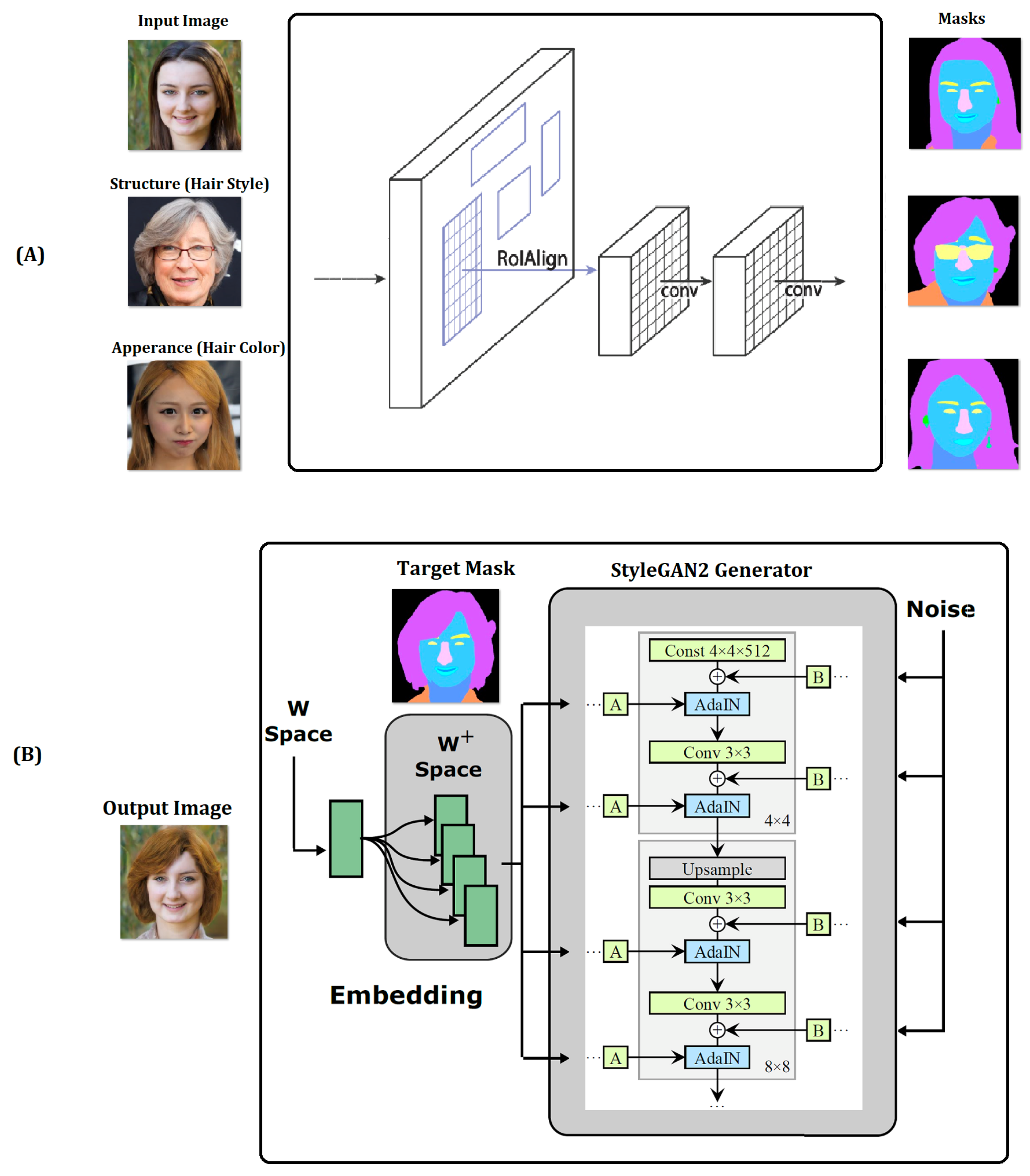
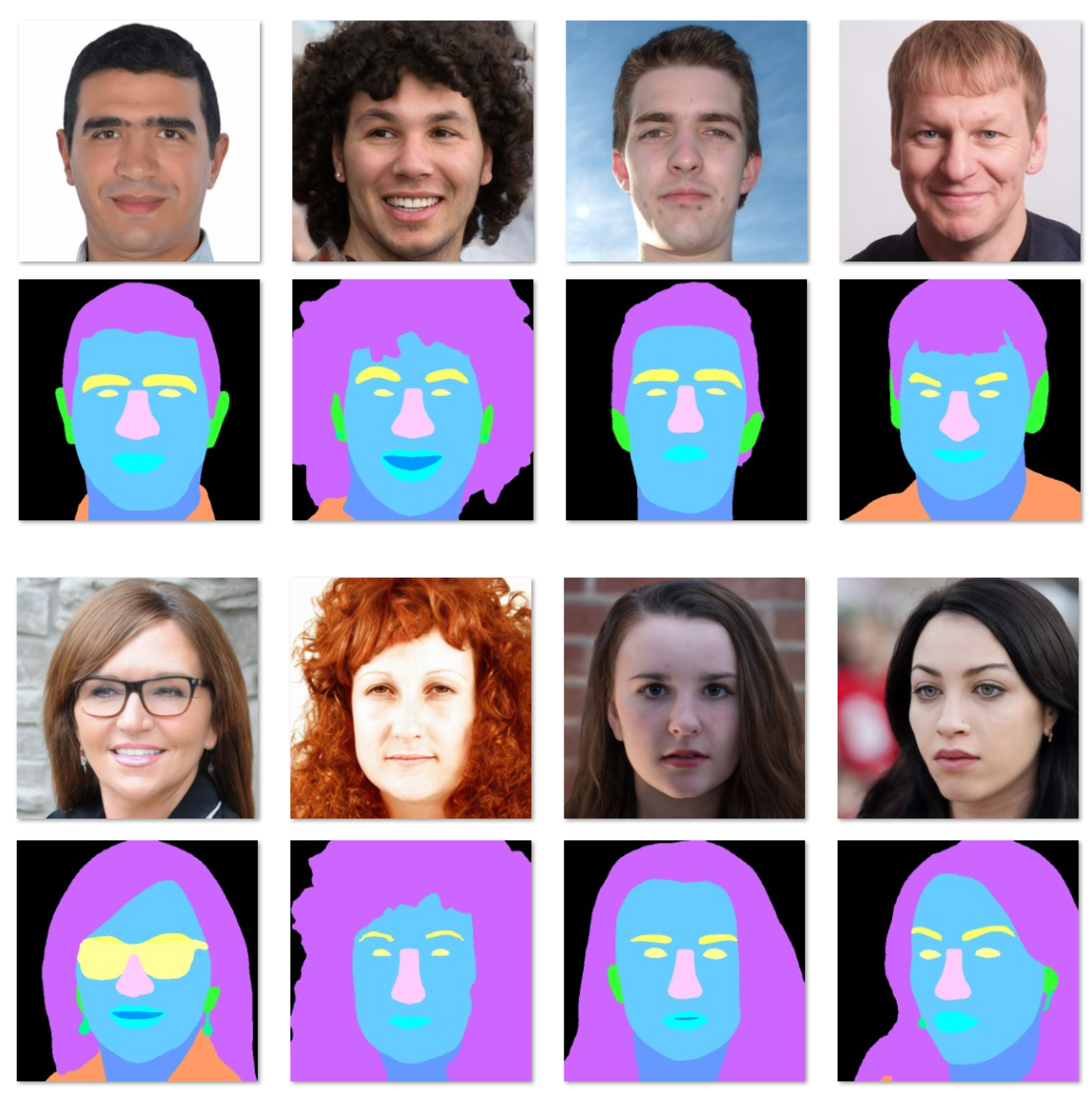
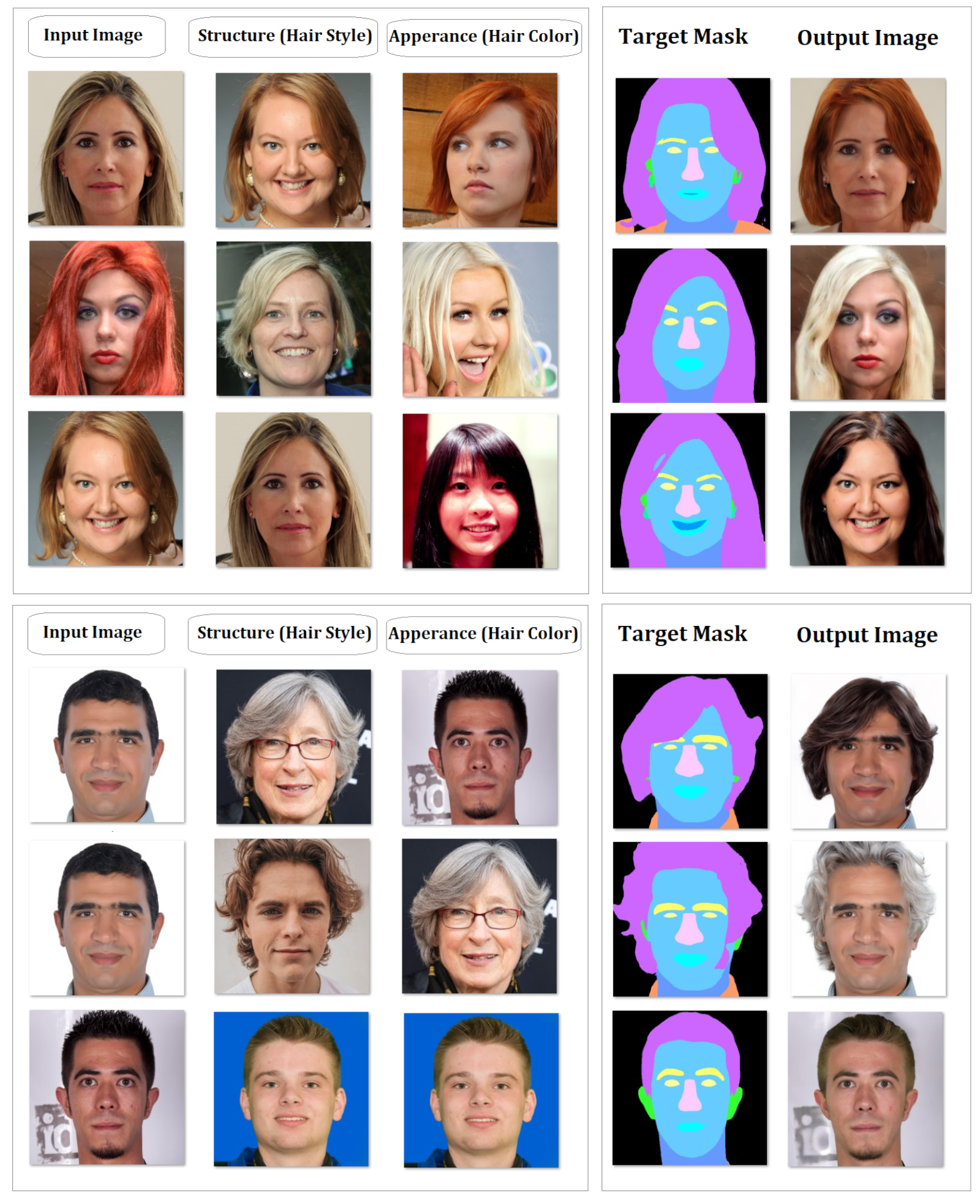
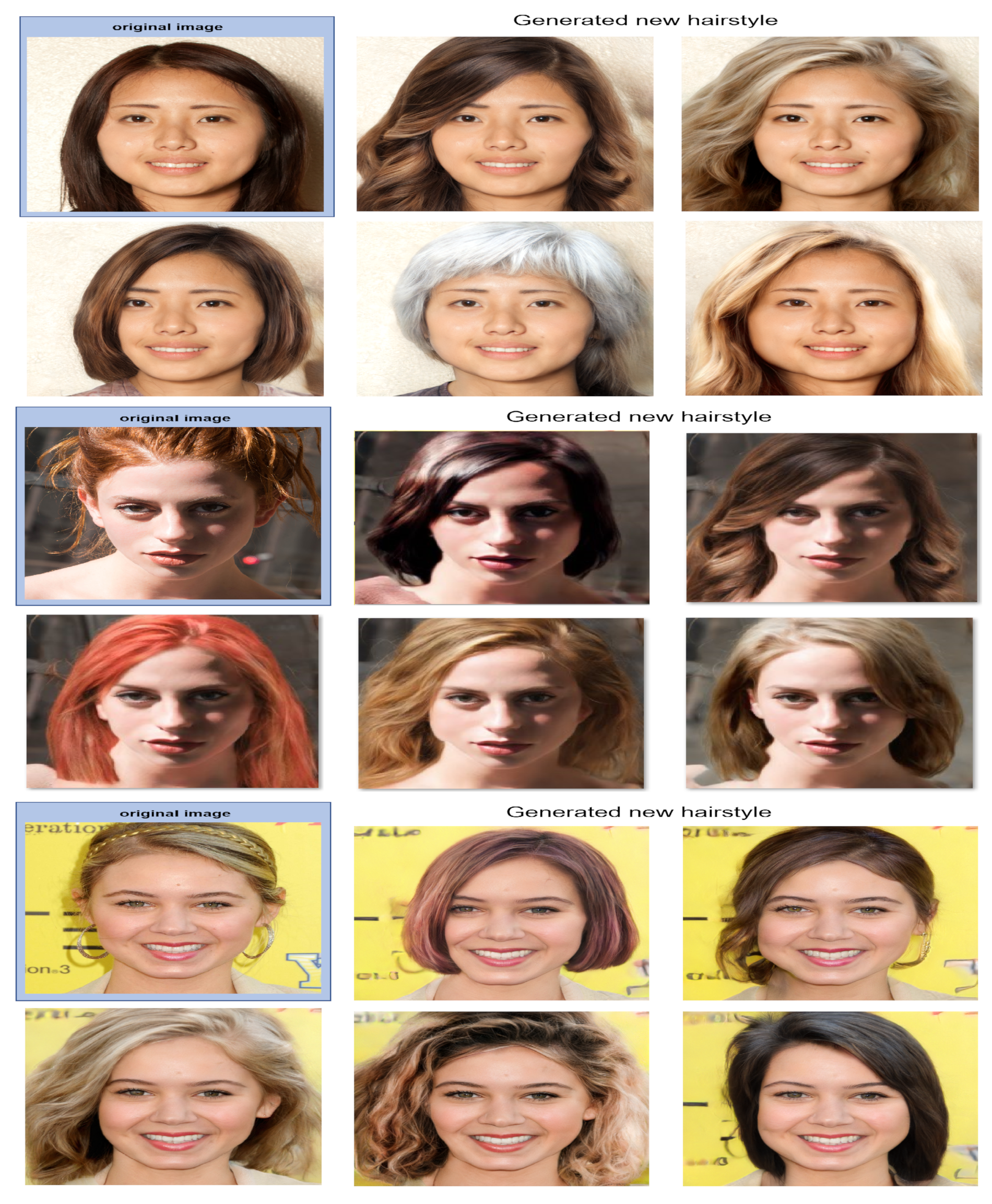
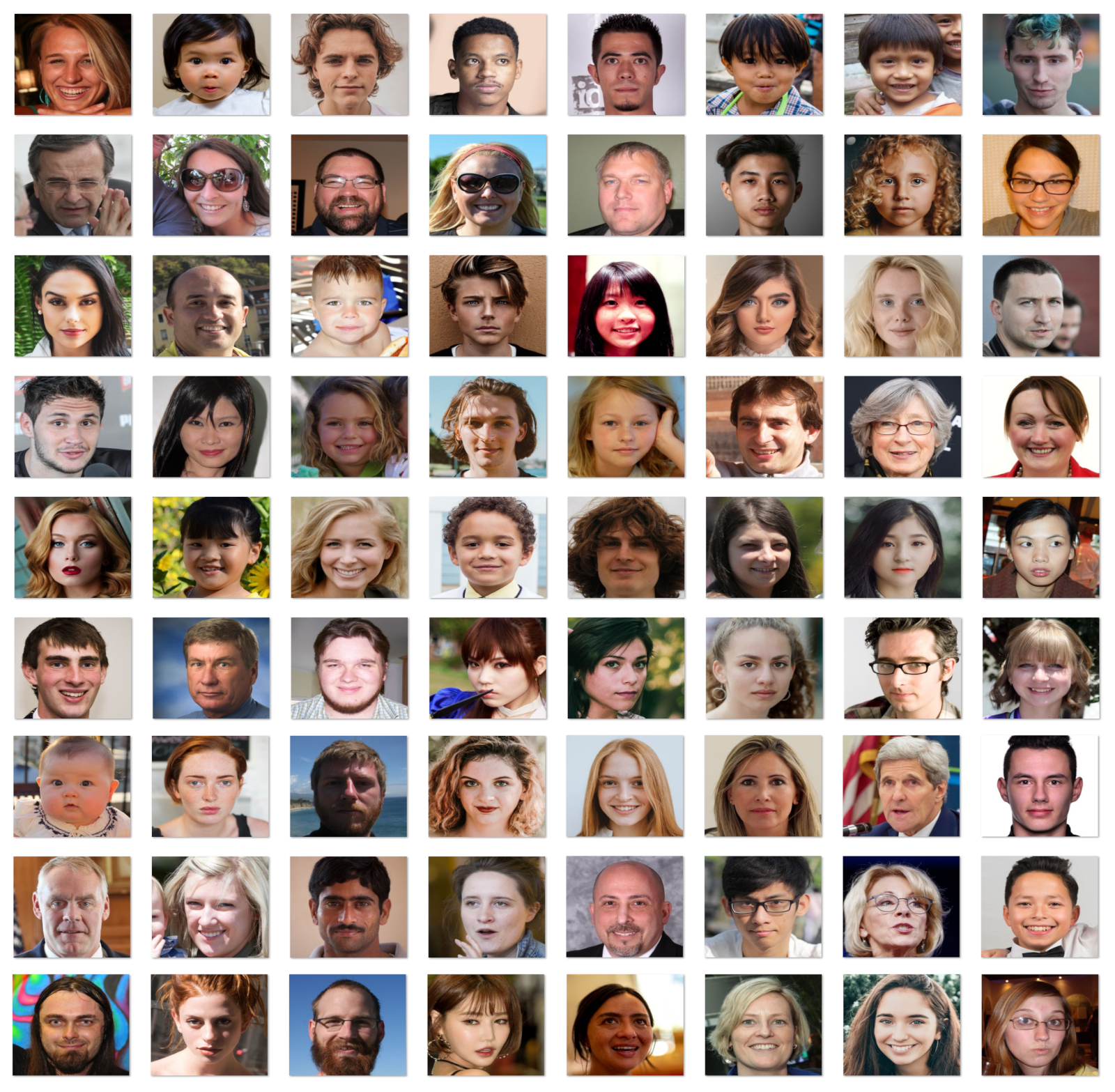
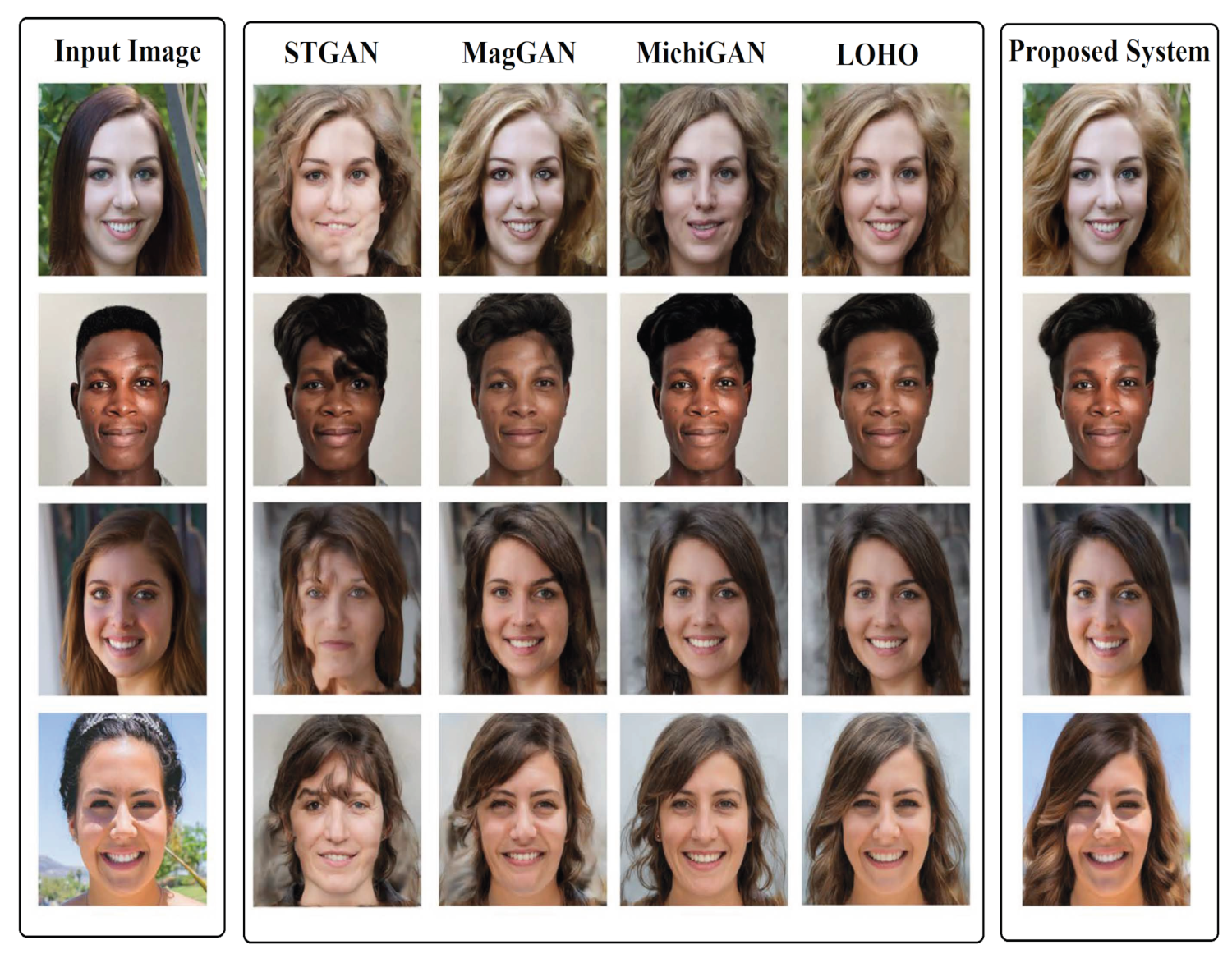
Publisher’s Note: MDPI stays neutral with regard to jurisdictional claims in published maps and institutional affiliations. |
© 2022 by the authors. Licensee MDPI, Basel, Switzerland. This article is an open access article distributed under the terms and conditions of the Creative Commons Attribution (CC BY) license (https://creativecommons.org/licenses/by/4.0/).
Share and Cite
Abdallah, M.S.; Cho, Y.-I. Virtual Hairstyle Service Using GANs & Segmentation Mask (Hairstyle Transfer System). Electronics 2022, 11, 3299. https://doi.org/10.3390/electronics11203299
Abdallah MS, Cho Y-I. Virtual Hairstyle Service Using GANs & Segmentation Mask (Hairstyle Transfer System). Electronics. 2022; 11(20):3299. https://doi.org/10.3390/electronics11203299
Chicago/Turabian StyleAbdallah, Mohamed S., and Young-Im Cho. 2022. "Virtual Hairstyle Service Using GANs & Segmentation Mask (Hairstyle Transfer System)" Electronics 11, no. 20: 3299. https://doi.org/10.3390/electronics11203299
APA StyleAbdallah, M. S., & Cho, Y.-I. (2022). Virtual Hairstyle Service Using GANs & Segmentation Mask (Hairstyle Transfer System). Electronics, 11(20), 3299. https://doi.org/10.3390/electronics11203299







